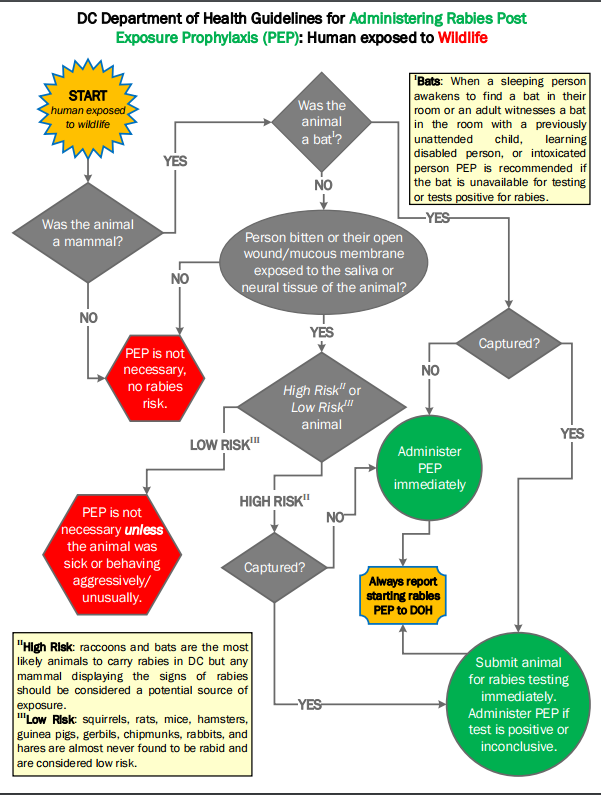|
Patients with potential rabies exposures are a relatively frequent reason for evaluation in an emergency room. Animal bites account for approximately 1% of all ER visits. Within the District of Columbia, all cats and dogs are required to be vaccinated against rabies and distemper from the age of four months, and after the initial set of shots, must be re vaccinated at least every 3 years. Not all owners may comply or have documentation readily available after an animal bite, and many patients may present after contact with a wild animal. As many residents may have already found, many tourists present after contact with squirrels, which are not known to carry rabies. DC DOH Vaccination, Bites, & Rabies Contact Phone: (202) 535-2323 Contact Fax: (202) 442-4817 Office Hours: Monday to Friday 8:15 am to 4:45 pm 899 North Capitol Street, NE Washington DC 20002 https://doh.dc.gov/service/vaccination-bites-and-rabies Rabid animal bite protocolWound care should start with cleaning the wound to prevent bacterial infection and retained debris. This will also reduce the amount of viral contamination, if rabies is present. When rabies PEP is deemed necessary in a person that has never been vaccinated before, both HRIG and the first PEP vaccine should be administered as soon as possible. The rabies virus is susceptible to antibodies when it first enters the body. This creates an opportunity to administer HRIG, neutralizing the virus before it can enter the nervous system.
Where should rabies PEP vaccines be given?PEP Vaccines should be given intramuscularly in the deltoid muscle. In children, the anteriolateral aspect of the thigh can also be considered. A cat is brought to the ER after biting a patient. The cat was vaccinated previously and has paperwork. What is the protocol?The cat should be quarantined for 10 days to observe for symptoms of rabies. Rabies PEP is not indicated in the patient at this time. The only exception is an animal that is obviously rabid when it bites a person; in this case the animal should be immediately euthanized and submitted for rabies testing. Rabies is only transmitted while animals display clinical signs. Once clinical signs manifest, most animals die within 8 days. This is what led to the recommendation of a 10 day quarantine period. An animal presents to your facility after being bitten by a wild animal. What is the protocol?If the animal was previously vaccinated, the wound should be cleaned and the animal quarantined for 45 days. If the animal was NOT previously vaccinated, they should immediately be euthanized and submitted for rabies testing. I was taking a selfie with a squirrel and bitten.Small mammals, including squirrels, rats, mice, hamsters, chipmunks and rabits have not been known to cause rabies among humans in the United States. Bites from these animals are not considered a risk for rabies, unless the animal was behaving in an unusual manner, in an area with widespread rabies.
0 Comments
Leave a Reply. |
Categories
Archive
February 2018
Please read our Terms of Use.
|
||||||


